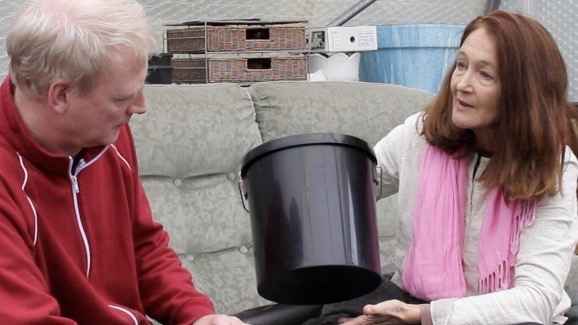How to make your own bokashi bin

A big challenge of growing in containers is keeping the soil fertile without having to buy new bags of compost each year. Adding home made worm compost is one of my favourite solutions. But what if you don't have space for a wormery or you're not very fond of worms? (Worm phobia is pretty common, I've discovered, since talking about worms in my workshops!) Bokashi is another option worth you considering. It requires little space (the size of a bucket), can be done inside or outside, and only takes two weeks. What's more, you can recycle ALL your food waste in a bokashi bin, even onion skins and cooked food, meat and fish.
What is bokashi?
Bokashi is a method of composting invented in Japan. It uses bran inoculated with EM (Effective Microorganisms) to rapidly break down food. “Bokashsified” waste can then be used to add fertility to your pots - mix it into your old compost (or put a layer at the bottom) and leave it for a couple of weeks to 'settle' before growing in it. Or you can use it in conjunction with a wormery or compost heap - simply add the product of your bokashi bin to your wormery a few handfuls at a time. I've started to put all the food I can't add to a wormery into bokashi, then move this into the wormery or the bottom of a pot when ready. I also add things that are slow to break down in a wormery - like potato skins - to bokashi first. They decompose a lot faster that way.
Any drawbacks to bokashi?
The main drawback of bokashi is that you have to buy a special bran to make it. Buying a large sized bag is the most economic option for most of us. (There are recipes to make your own bran on the net but you need a large space to dry the bran.) Bokashi is also, in my opinion, a bit less flexible and pleasant to use than worm compost. But it works well, and is still an excellent solution for many situations (and also great to use in conjunction with a wormery). Do give it a try.
How to make your own bokashi bin
To make bokashi, you'll need a bokashi bin or two. You can buy these or it's easy to make your own. Bokashi expert, Woody, from Bubblehouse Worms shows you how to make a low cost and effective one in the video below (check out her and Ken's website for more info on bokashi and wormeries - and supplies for both).
If you want to compost all your waste food in bokashi you'll need two bins. Fill one, then, while you are leaving that to pickle for two weeks, fill the other. Obviously if you just want to bokashi some of your waste food, one bokashi bin will do the job perfectly.
Your Turn
If you've tried bokashi, I'd love to hear how you've found it in the comments below. Or if you try making your own bin following Woody's instructions, do let me know in the comments how you got on.

45 comments
Depends on the quality of the product. Look for an official EM based bran. Agriton UK do some?
Leave a comment